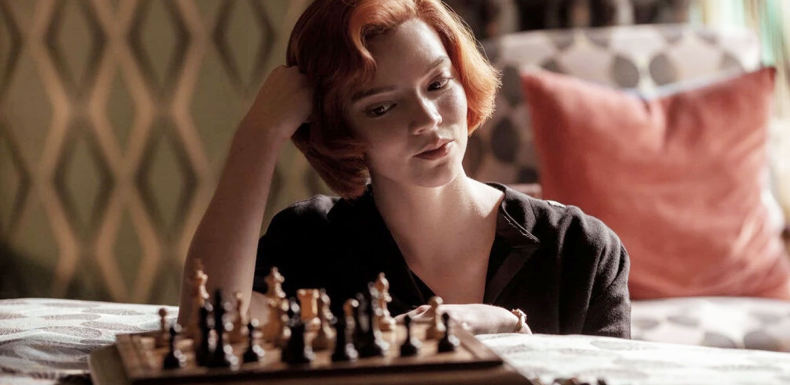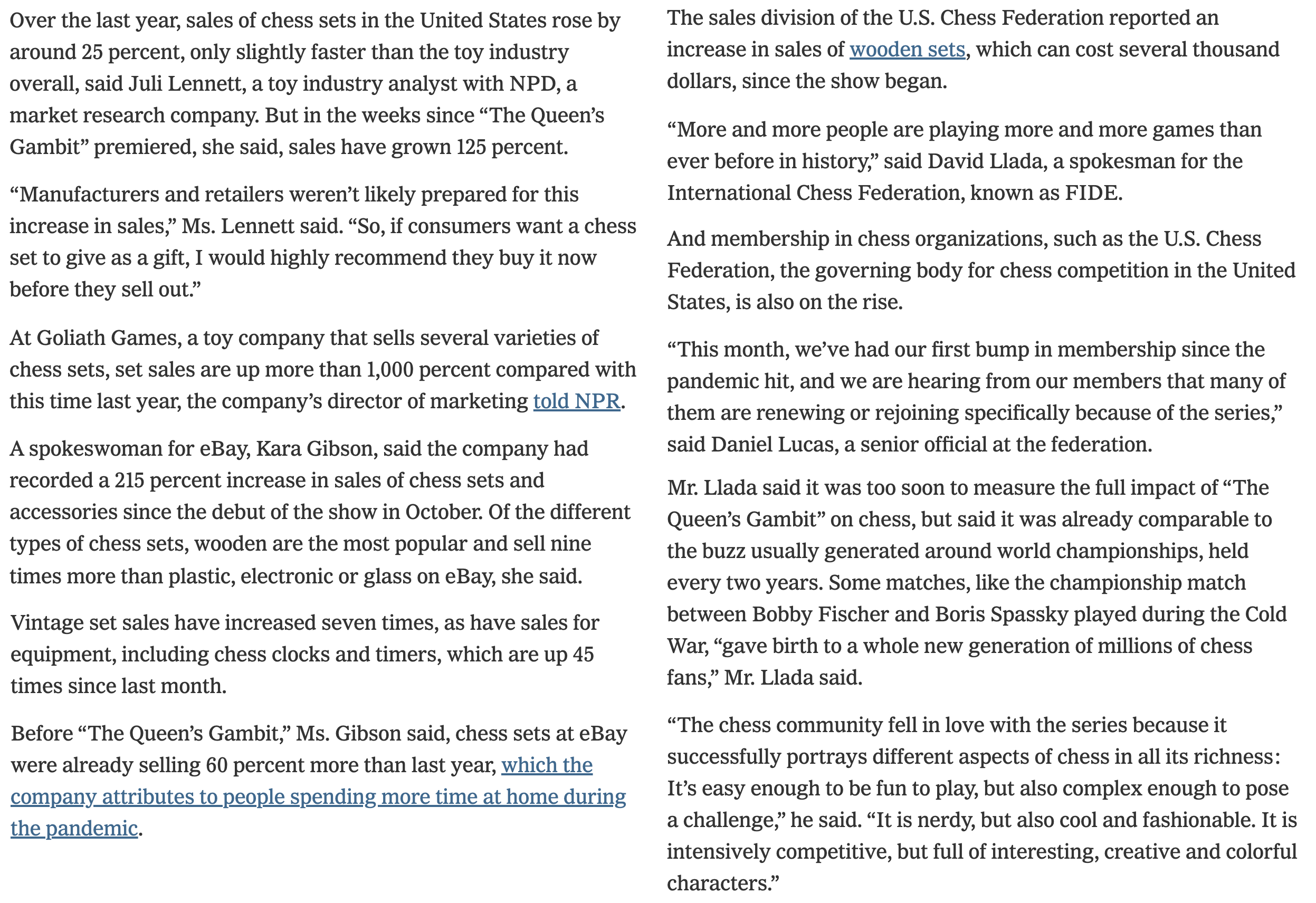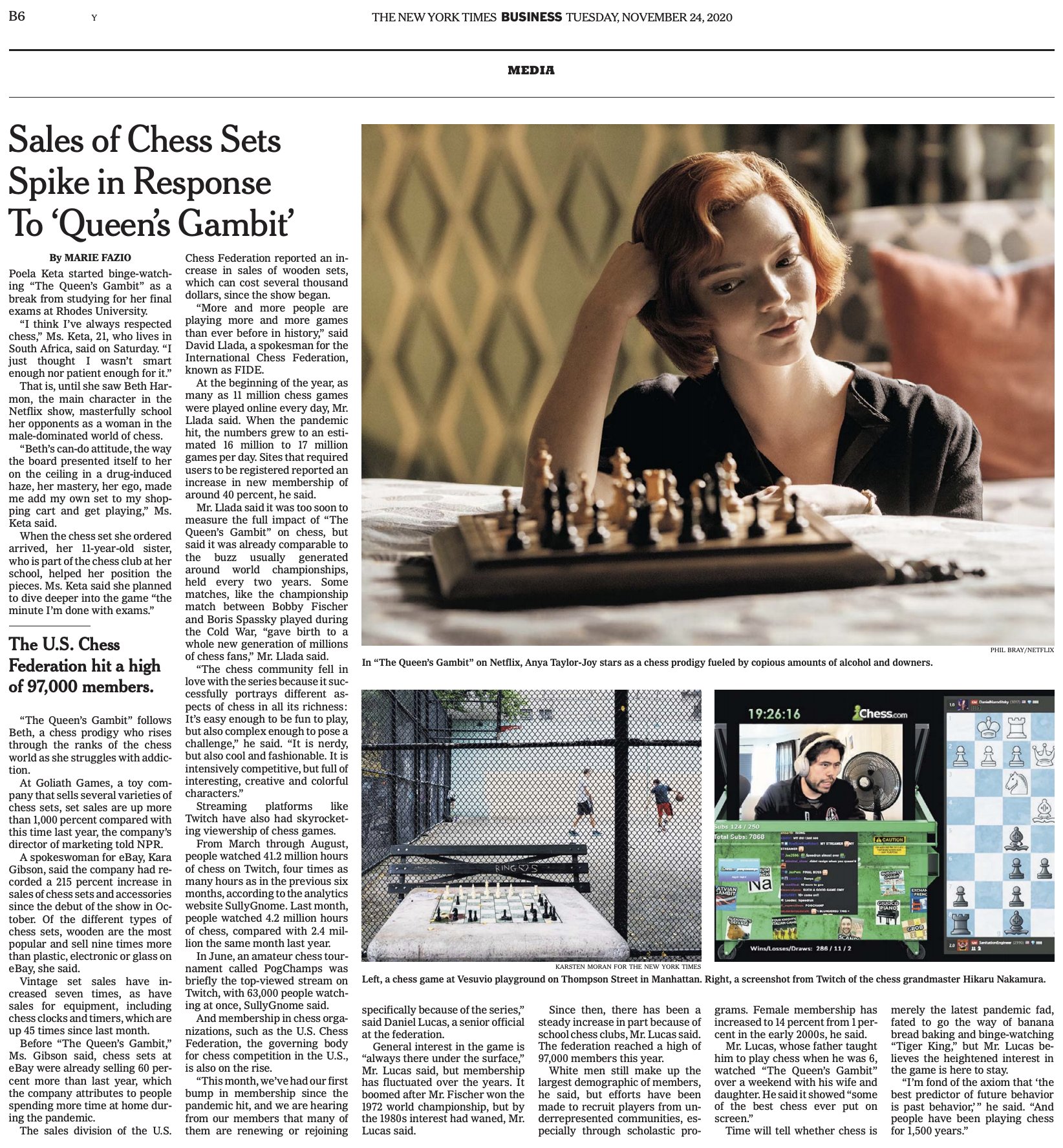
The New York Times, on the November 24th issue, reported that sales of chess sets have dramatically increased in recent times.
The timing of the increase in sales was earlier due to the pandemic-induced stay-at-home rules. But in recent times, it was due to a show on Netflix, called The Queen’s Gambit.

I’m yet to see the show (I will surely, eventually), so I don’t know if the show glorifies the game in any specific way that creates a compelling call-to-action for viewers to buy chess sets afresh (if they didn’t have one already). But the idea that people/viewers felt compelled to buy something depicted in a show they watched even if the show is not explicitly selling it is almost like a wet dream for advertisers and marketers.

Advertisers/marketers do this intentionally – the brand intends to place itself in a pop culture artefact like a movie or a TV show (called in-show/in-film placement/advertising) and as a result of that visibility, people would feel interested in buying that product.
Some of the best examples of intentional product placement in films include Ray-Ban Wayfarers in Risky Business (1983) and Ray-Ban Aviators in Top Gun (1986), both starring Tom Cruise.
In fact, Ray-Ban was planning to discontinue Wayfarers because it had sold only 18,000 units in 1982. After the in-film placement, it sold 360,000 units in 1982! Ray-Ban had hired an agency called Unique, to place their models in as many as 60 TV shows and movies, and by 1986, sales rose to 1.5 million pairs!
But when the impact is felt not by a single brand or a product, but by an entire category (or a game, in the case of The Queen’s Gambit), that’s mighty interesting to observe from the marketing lens.
For instance, Alexander Payne’s 2004 film Sideways, starring Paul Giamatti showed him as someone who loved pinot noir wine, and the film led to a boost in sales of this red wine after its release! Not a single product, but a category!
I recall in the late 80s when actress Nadhiya was ruling Tamil cinema after her trailblazing debut in the film, Poove Poochooda Vaa (a remake of the Malayalam film, Nokkethadhoorathu Kannum Nattu), there was a craze for dresses in a color that was named, “Nadhiya manjal” (manjal is yellow in Tamil). I reckon it was due to one of her well-noted costumes in one of her early films. I recall seeing frocks for young girls being sold as ‘Nadhiya manjal paavaadai’ during that period in Tamil Nadu 🙂
Then there was ‘Khushbu Idly’, sold in a hat-doff to actress Khushbu’s cheeks 🙂
In both examples, smart shopkeepers took advantage of a current (then) craze and packaged it cleverly to create desire and demand.
In the case of the Netflix show, there are 2 levels of interest.
The first is the word-of-mouth for the show itself. That it is worth watching is the first level of creating desire, and demand for Netflix and the show. This is a call-to-action to watch the show, created by word-of-mouth.
Netflix is consistently good at this, considering many of their shows go ‘viral’ and people feel FOMO. Tiger King was a recent example of this happening really well. It’s both a function of content that Netflix knows (from their treasure trove of audience data) and solid PR/marketing efforts that they do around their shows.
The second is unintended, in this case – the interest in chess, and the specific call-to-action to buy chess sets!
But think about it – what if people who are responsible for marketing ‘interests’ and user behavior (as against individual products or services) worked with showrunners or creative writers/producers and ‘place’ them in shows?
For example, the Association of Mutual Funds in India (AMFI), which has been running the ‘Mutual Funds Sahi Hai’ campaign, could work with writers to co-create a show where a lot of people gain from investing in mutual funds. But, to make it really useful and impactful, it should not seem like an extended ad campaign, but as an enjoyable show that people would want to watch and inform others that they enjoyed it.
The tobacco industry has exploited this very, very effectively. It wasn’t about specific brands of cigarettes but the mere showcase of someone smoking in one or more scenes. And given the size and scale of such ‘placement’, the entire tobacco industry gained enormously.
See: .
Do you recall any other user-behavior triggered by its depiction in pop culture artefacts like films and TV shows?
